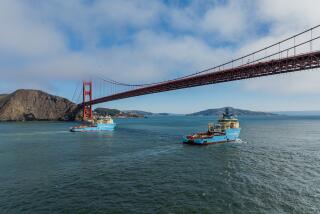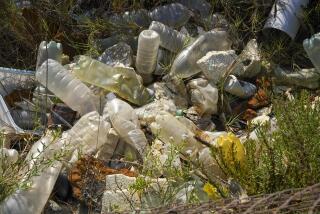Microbeads a major problem in L.A. River

Marcus Eriksen tests Los Angeles River water for microbeads found in facial cleansers and other household products. The tiny plastic beads absorb toxins, are not biodegradable and pose an environmental threat to urban waterways and oceans.
Scientist Marcus Eriksen stood ankle deep in the murky Los Angeles River on Friday and dipped a net into the water, looking for a problem.
Eriksen was searching for “microbeads,” bits of plastic no bigger than salt grains that absorb toxins such as motor oil and insecticides as they tumble downstream and into the Pacific Ocean.
The tiny polyethylene and polypropylene beads are an emerging concern among scientists and environmentalists. The beads come mostly from personal care products such as facial exfoliants and body washes. They are not biodegradable, however, and because they are not removed easily by wastewater treatment plants, they flow out to sea and enter the food chain.
“Microplastic is now a ubiquitous contaminant in the Pacific Ocean — and seas around the world,” said Eriksen, a scientist with the 5 Gyres Institute, a nonprofit dedicated to researching plastics in the world’s waterways. “We believe that 80% of it comes from coastal watersheds like Los Angeles.”
Eriksen is just starting to test the Los Angeles River to determine if it holds microbeads, and if so, their source. On Friday, he found what he was looking for in about 10 minutes.
Near the confluence of the river and Arroyo Seco, about three miles north of downtown, Eriksen found a handful of algae and wriggling leeches speckled with tiny filaments, shards and beads that could have come from myriad sources: laundry wastewater, degraded plastic bags, stir sticks, personal care products.
“The scary thing is that the beads sponge up toxins, then get consumed by organisms from shellfish to crabs to fish” later eaten by humans, he said.
Scientists are only beginning to understand the hazards posed by microplastic pollution in the world’s oceans and inland waterways. In 2012, Eriksen and a team of researchers discovered large amounts of microbeads and other microplastic pollution in the Great Lakes. Those findings prompted a coalition of mayors of Great Lakes cities to ask the U.S. Environmental Protection Agency to determine the possible health risks to lake ecosystems and humans.
A year later, 5 Gyres launched a campaign asking the manufacturers of personal care products to remove plastic microbeads and replace them with nonplastic alternatives such as crushed walnut husks and apricot kernels that will degrade naturally. Several companies have agreed to phase microbeads out of their product lines.
In a statement, the Johnson & Johnson Family of Consumer Companies, for example, said it has “stopped developing new products containing polyethylene microbeads.” The company expects by 2015 to have replaced microbeads with alternatives in half the products that currently use them.
That’s not soon enough for 5 Gyres, which is circulating a petition titled, “Get plastic off my face and out of my water now!”
Standing in the river, Eriksen demonstrated the problem. He squeezed several drops of Johnson & Johnson’s Clean and Clear facial scrub into a small jar full of water, then shook it up and filtered the foamy mixture through a black T-shirt.
Left behind on the fabric were hundreds of tiny white, pink and blue plastic beads. “We estimate there are about 330,000 microbeads per tube,” he said.
The source of beads washing down the L.A. River isn’t known yet. In rainy weather, the river holds vast amounts of runoff from across the region. But in the current drought, 80% of the flow comes from the Donald C. Tillman Water Reclamation Plant, which sits 12 miles upstream from Eriksen’s survey site and treats sewage from the homes of 800,000 San Fernando Valley residents. The other 20% is from myriad sources in the area.
Jimmy Tokeshi, a spokesman for the Los Angeles Department of Public Works, suggested it’s not coming from the plant, which sends sewage through a series of holding tanks, digesters, filters and sanitizers before discharging the treated water into the river at a rate up to 27 million gallons a day.
“The city of L.A. meets and/or exceeds all Clean Water Act requirements as well as all local, county and state water regulations,” Tokeshi said. Using cloth filters, “We capture microplastics that are larger in size than 10 microns, or 0.01 millimeters, in the water reclamation plant,” he said.
Most of the visible plastic debris Eriksen found was much larger than 10 microns in size.
Eriksen said he doesn’t yet know the origin of the beads. But he said his nets don’t lie.
“Using a net only 2 feet wide for 10 minutes in a stream a few hundred feet across, I caught dozens of bits of plastic,” he said. “So, it’s easy to extrapolate that millions of plastic particles flow through this channel every day.”
He pivoted to face downstream, and with a wave of his muddy hands, he declared: “That’s a problem.”







